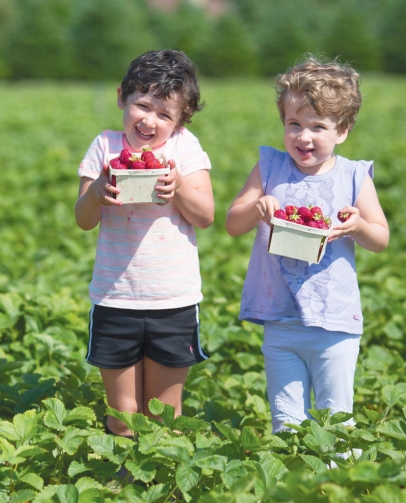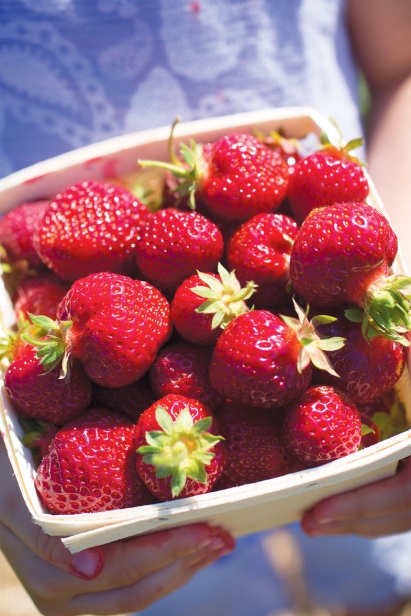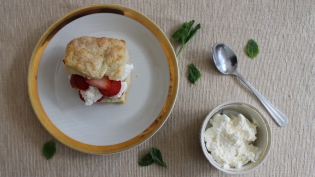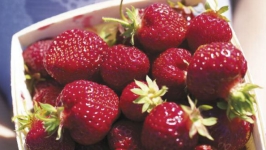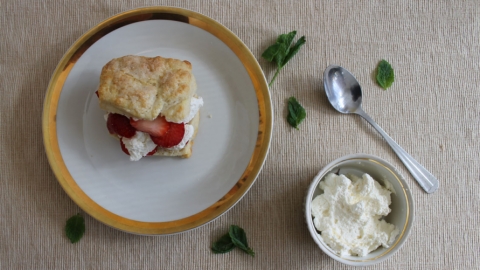Pick Your Own at the Strawberry Patch
Can you conjure up the first time you went strawberry picking in Rhode Island? Think of one of those first warm June days, with the sun bringing up the sweet earthy smell of the straw around the plants. Then, when you kneel to pick them, you catch a whiff of that lusty ripe-strawberry scent.
You’re not sure whether to taste just one before you begin the serious business of filling a container or whether that will make it harder to refrain from nibbling as you work your way down a row.
Most often, you’ve come with your kids or grandkids or neighbor kids (though sometimes you’ve come on your own, just a “big kid”). With children in tow, there’s added fun but added duties as well. You simply must keep an eye on how many are gathered vs. how many disappear into young mouths.
Comparisons of size—”Look how big this one is!”—of shape—”This one looks like a mouse!”—of color—”I’ve never seen a redder strawberry!”—of amount picked—”My box is fuller than yours!” echo around the patch. Talk of jams or jelly, shortcakes or pie ricochet among the pickers, as do newer recipes, with strawberries in salads, salsas or yogurt parfaits. The anticipation keeps you picking, as you pull your sun hat lower and put on more sunscreen before checking the kids for the same.
In Rhode Island, there are plenty of pick-your-own (PYO) farms to choose from across the state (see box), and two are Quonset View Farm, in Portsmouth, and Earth Care Farm, in Charlestown. Quonset View’s investment in this fruit is considerably larger than Earth Care’s: 10 acres compared to just under one acre. And their growing practices differ in several ways.
But farm owner William Cotta at Quonset View and farm manager John Barth at Earth Care would agree that they enjoy the harvest of visitors to their farms almost as much as the crop itself. Father’s Day and the Saturday before it can be the busiest days of the strawberry season, given that the strawberries only last about five weeks and usually begin bearing ripe fruit around the 10th of June, according to Cotta. On some days, his farm has seen 1,000 people come through.
“It’s something for the whole family to do in the early summer,” he observes.
At the smaller Charlestown farm, Barth has often welcomed homeschoolers and mother’s play groups, as well as parents and kids.
Both farms plant several varieties of strawberries, with Cotta’s crew depending on berries that bear early, mid and late season, planted in different parts of the field. Barth mentions that at Earth Care, the varieties tend to get mixed together, so there might be more of a “hunt” among the plants to find the ripest ones.
“A lot of people grow strawberries like an annual,” Barth says. “We till under last year’s crop, but the runners, the ‘daughters,’ are kept. We just flip-flop the rows: What was last year’s aisle becomes this year’s row.
“We’re able to accomplish this because of the fertility of the soil,” he continues. “Some farms say that berries drop off in size from the original but 85% of our new crop were transplants, and because of the three feet of compost, we don’t experience that decrease in size.”
Although Earth Care Farm no longer carries an organic certification, they still pursue holistic practices, such as the rotation, no spraying and lots of straw to overwinter them.
“That really helps to give them a head start in the springtime,” he adds.
Cotta agrees and worries some years about getting enough straw to cover all his plants. His team puts four inches all over the plants (220 bales to each acre) and with all the snow on top of that this year, he is looking forward to a good season.
“The straw keeps the berries nice and clean,” Cotta explains, “and people can kneel in the straw to pick them. It keeps the plants from freezing and thawing and the roots from breaking.”
Cotta and Barth both affirm that strawberries like a soil that is not too dry but definitely not too moist. If it doesn’t drain properly, there’s the possibility of molds developing on the fruit. There’s also a small fruit fly that can get inside the berry, but neither farm sprays their crops. And both farmers know that the strongest enemy to strawberries, aside from too much rain, is weeds.
“It can be intense, as far as labor,” Barth says. “But we’ve incorporated other things into that same growing season, such as peas, rhubarb and cut flowers [all PYO] so that people who come to the farm can go home with more than just strawberries.”
Cotta’s farm also grows potatoes, pumpkins, squash and Christmas trees. It was the PYO visitors who first pointed out the farm’s view of Quonset across the Bay, because the farm sits high on a hill on Aquidneck Island.
Cotta is a third-generation family member to work the farm, established in 1902, and fifth generation relatives are also now working the farm. He knows that the view is special for people who come to pick their berries, but he’s also proud of the “nice straight rows” and the rich lush taste of local berries that haven’t had to be picked green to ship them from a long distance, like California strawberries.
For those who would like that distance to be right outside their back door, i.e. growing strawberries in their back yard, the URI Cooperative Extension can offer tons of helpful advice and information. Heather Faubert, the Cooperative Extension fruit specialist, emphasizes that any strawberry bed must contain a lot of organic matter, with a neutral pH close to 6.5.
“A raised bed will warm soil earlier and it will be easier to weed,” she says. “Growing them in a raised bed will also help with drainage, since that is such an important issue for strawberries.”
The Cooperative Extension publication from the University of Maine, which Faubert recommended (UMaine.edu/publications/ 2067e), stresses that a strawberry bed needs full sunlight and, if possible, a slight ground slope. Half a dozen varieties are highlighted, with descriptions of fruit size, shape, flavor, productivity and ripening habits. With careful care, strawberry beds are estimated to produce good crops for three to five years, beginning one year after planting.
However, the bed of strawberries I inherited when we moved into our house 36 years ago, despite severe neglect and bird thievery, still produces a few pints of ruby gems every year. Just think: If I were to dedicate a raised bed to them, not only could we give them a hearty soil re-start, better drainage and better mulching, but we might better protect them from bird beaks and human missteps and make more jam!
As it is, I have made jam with honey (strawberries hold their own against the honey taste) and “freezer jams,” with no sweetener. But most often, I just pick them for my morning cereal or put them in the freezer for future smoothies. Or, my very favorite: I mash a few fresh ones with a fork atop a piece of buttered toast and let the sweet-tart juiciness linger on my tongue.


